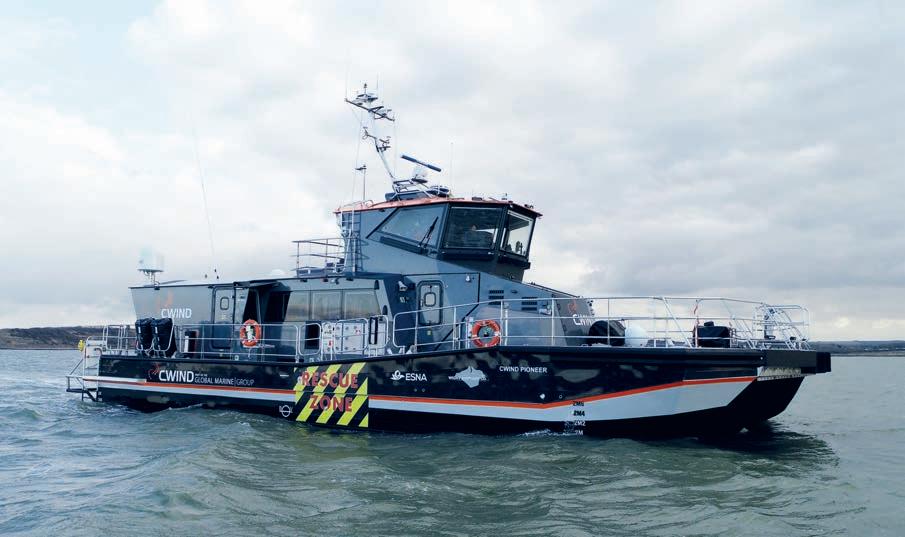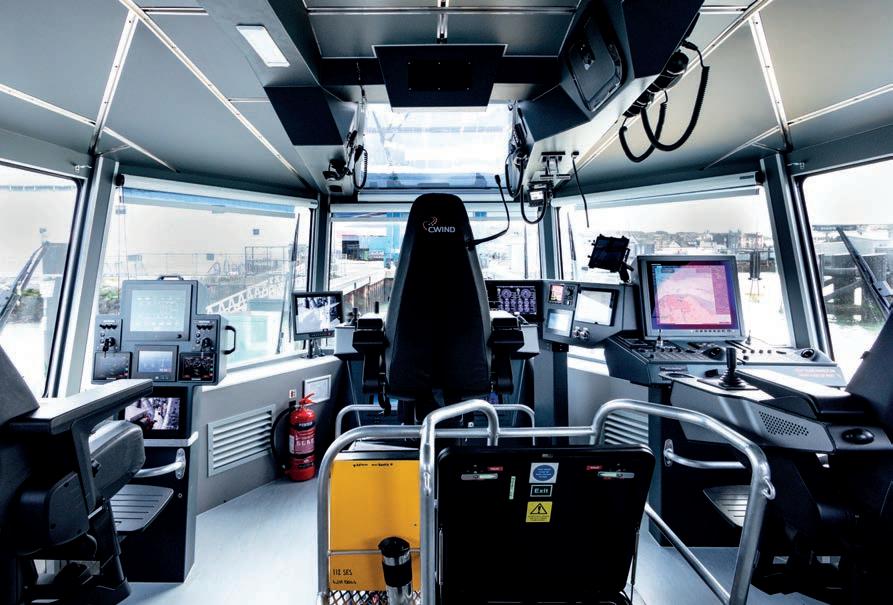
4 minute read
A step-change for the ofshore wind
Named the CWind Pioneer the CTV demonstrates its position at the forefront of crew transfer vessel innovation.
A step-change for the offshore wind industry
Advertisement
CWIND DELIVERS THE WORLD’S FIRST HYBRID POWERED SURFACE EFFECT SHIP (SES). NAMED THE CWIND PIONEER THE CTV DEMONSTRATES ITS POSITION AT THE FOREFRONT OF CREW TRANSFER VESSEL INNOVATION.
ALL PHOTOS COURTESY OF CWIND. The vessel was developed in response to an industry-wide push to develop and deploy innovatve technologies that reduce CO2 emissions, while cost-efectvely servicing wind farms located further ofshore. The CWind Pioneer achieves this through a hybrid diesel and batery electric power system which enables the vessel to operate purely on batery power while in harbour or at standby in the wind farm, resultng in a decrease in fuel burn and CO2. The hybrid SES propulsion engine delivers sprint speed and extreme bollard push from its 1,600kW installed diesel engines, which can be batery boosted up to 1,800kW. The vessel was built by Wight Shipyard, a UK aluminium and high-speed craf vessel builder.
Comfortable experience
With surface efect hull form and heave compensaton technology, the CWind Pioneer can operate at speeds exceeding 43.5 knots, and can transit and transfer safely in sea states in excess of 1.8m Hs, while minimising moton and acceleraton through its air cushion moton control system, resultng in a smoother, more comfortable CTV experience for technicians and crew. The overall design and build, with 24 passenger capacity, pays partcular atenton to technician and crew health, safety and comfort, delivering the workforce in the best possible work-ready conditon, resultng in increased operaton days ofshore for our client’s O&M and constructon actvites. >>
The overall design and build, with 24 passenger capacity, pays particular attention to technician and crew health, safety and comfort.

Low cost, low carbon
At a speed of 43.5 knots, the Pioneer is over 20% more fuel efcient than conventonal CTVs running at 24 knots on a kilometre for kilometre basis. For a typical wind farm situated 55km from port, this translates to a reducton of over 110t of CO2 per vessel, per year, by using the hybrid SES. This fgure excludes the savings of the hybrid system, which will allow the vessel to be zero emission ship infeld while technicians are carrying out their work on the turbines. Specifc fgures will be shared once these savings are proven, but inital desk top studies suggest a 30%-50% saving over conventonal vessels. The high transit speed of the vessel also means wind farms previously serviceable only by an expensive SOV, can now be reached by the SES CTV within 60 minutes, giving wind farm owners and operators more low cost, low carbon optons when determining their transfer strategy.
Ørsted
Nathanael Allison, Managing Director of CWind says, “The launch of the CWind Pioneer marks a signifcant milestone for the industry and helps pave the way towards achieving net zero targets. The vessel utlises revolutonary technology to meet the needs of the market and our customers who want a greener, safer, and more efcient Crew Transfer Vessel to support their commercial and green objectves. With the CWind Pioneer we have delivered just that – a new generaton of CTVs.” The CWind Pioneer will be used at the Borssele 1 and 2 ofshore wind farms through a long-term charter contract agreement with Ørsted. Using the CWind Pioneer enables Ørsted to not only deliver and service their wind farms efciently through reduced transit tmes, but also supports their ambiton of a world that runs entrely on green energy.
Fun and challenging

The Hybrid SES crew transfer vessel was developed in partnership with ESNA, a ship design company based in Kristansand, Norway. ESNA specialises in low emissions technologies and surface efect ship development, to deliver commercially compettve vessels with signifcant carbon reductons by design. Trygve H. Espeland, Naval Architect and Co-founder of ESNA, states, “We are delighted to see the launch of the CWind Pioneer. She is not only a step-change for the ofshore wind industry, but also for the SES design, as she is the frst SES with 100% electric air cushion systems, which were both fun and challenging to achieve. As a SES, she is reducing emissions by ofering low resistance at high speed, and the air cushion moton damping is allowing ofshore operatons in same wave heights as larger vessels. By choosing a SES you can, therefore, reduce emissions by simply building a smaller vessel for the same job.”











